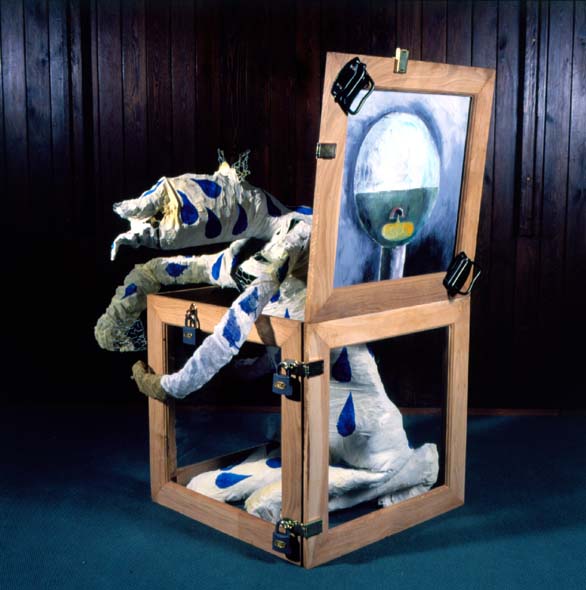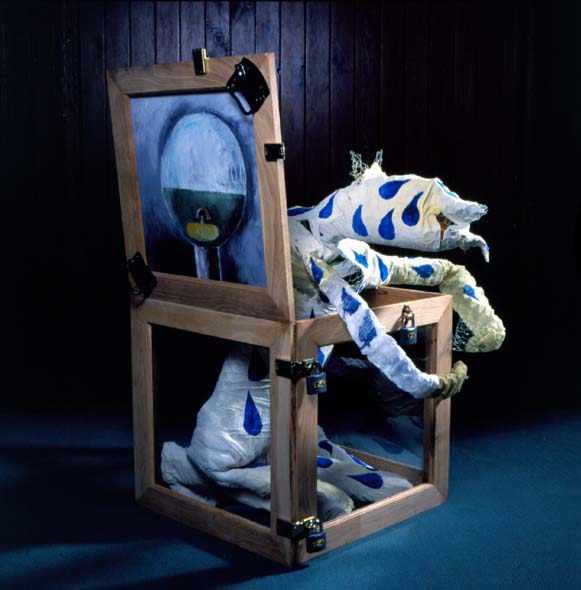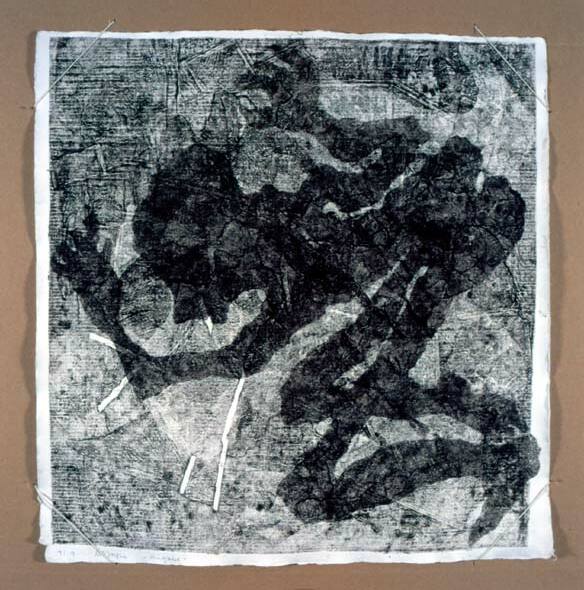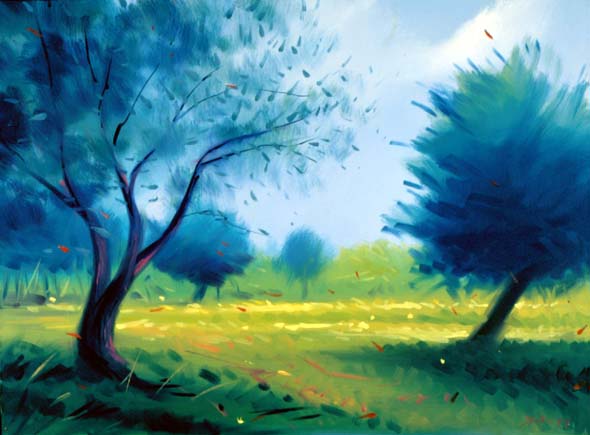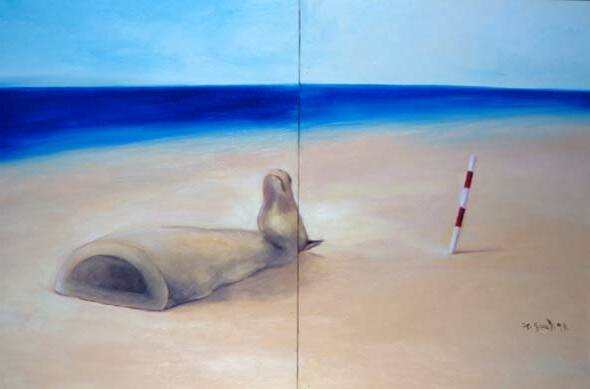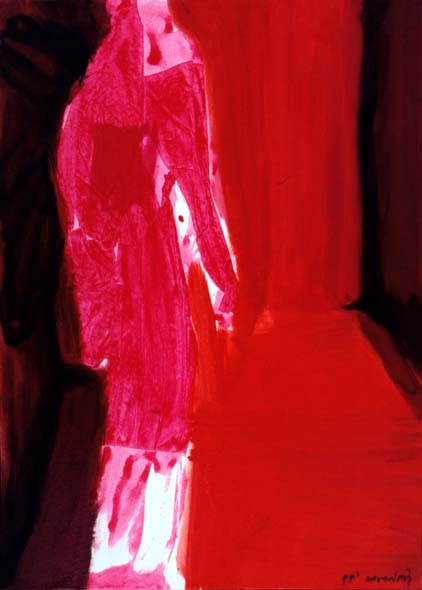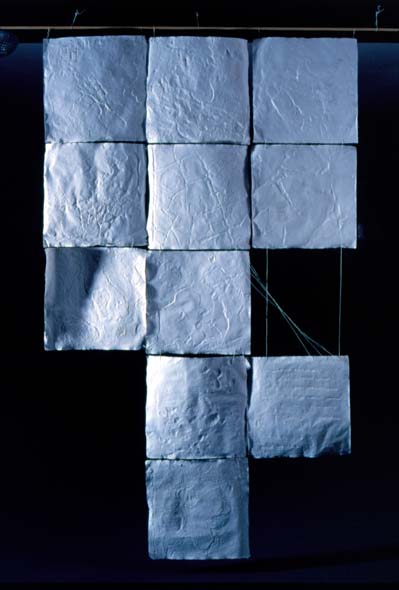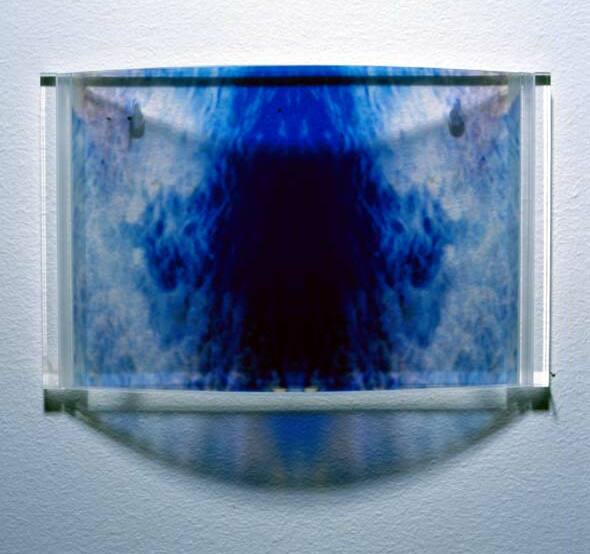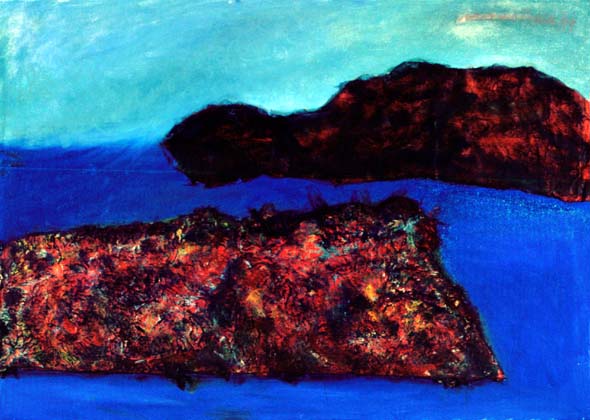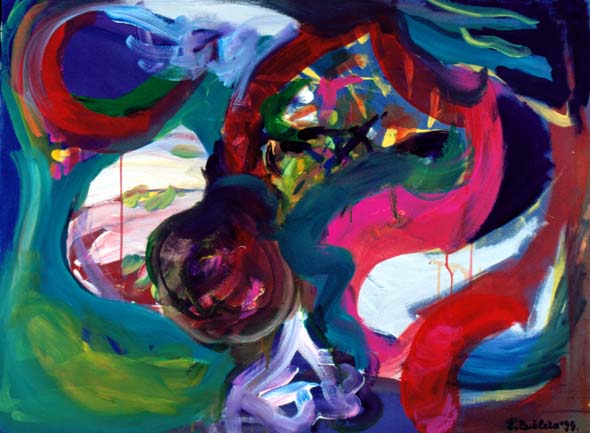Medulin 1999 (EN)
International art colony
M e d u l i n 1999
Mediterranean Reflections
Thanks to the determination and hard work of Aleksandra Rotar - the initiator and organiser of the Medulin artists' colony, and thanks to the hosts - the Medulin Hotel in Medulin where the artists stayed, this late summer gathering has been held since 1997. The third in a row - the MEDULIN 99 international art colony gathered twelve artists from Austria, Germany, and Croatia. Twelve artistic individuals, each working in their own thematic, stylistic and field, created, as was expected, a heterogeneous collection of pieces.
with a piece formed of an open trunk with a painted portrait on the lid, and a three dimensional doll with anthropomorphic-animal features, observing the world by lifting itself from its "cage" , has given form to her intimate thoughts about human existence, man's desire to step out, to flee from the limitations of a given, chosen or imposed "script" into a different, new place, an imagined "sunny island". On the other hand, the "cage" is the symbol of real space, a safe "intrauterine" refuge which in the ambiguous code of meaning used by the artist strips the mask from the anathema of life: the tension between the primal need to preserve one's own real "lair" and the desire, the longing to flee, to give oneself up to the call of the imagined "starry spaces".
in her work, (graphics) evokes a "terrifying" picture of the sub-conscious and spiritual nightmares. On a background brought to life by the play of basic brown colours, there is the shadow of a grotesque figure, stiff and cramped up in the background. The distorted arrangement of the oversized limbs, the position of the body, the shocking thinness, give this dark figure a powerful impression, aided by the one-dimensional colours.
has depicted a landscape with a broad gesture, which gains a new, Mediterranean flavour, and by use of colour he has transformed the immediate form into an impressive experience of the landscape. Depriving the motif of its distinctive points, by blurring the middle ground, in blue and yellow colours he has achieved the feeling of a landscape, an atmosphere where the lines in the middle ground merge in the hot, shimmering rays of a sunny day.
has transferred her vision to a show of symbolic meaning. On a stage, an empty and anxious space defined by the broad, angled belt of a sandy shore and the line of the sea placed opposite it and the straight line of the sky on the horizon, is the main "narrator" of the symbolic script of the foreground: a laid lawn (a piece), the solidly formed, tactile body of a horse, and beside him a "measuring rod". The static character of the clearly separated zones is supported by the vertically raised head of the horse and the rod which stiffens the structure of the composition, not only by contrasting the diagonal lines of the composition, but also the central points of the viewer's gaze. This surreal, theatrical, darkly intoned scene arouses thoughts of loneliness, the unstoppable flow of time, death.
has visualised her concept of the relationship between men and women by artistic expression making use of various crafts, including hand sewing. From a black background emerge the busts of male and female forms, turned towards each other, and their communication is emphasised, along with their position, as in comic strips, by lines linking them - the coming and going of "thought waves" from their heads. The "story" of male-female dualism is also enforced by colours: blue for the male and pink for the female.
reinterprets reality, more imagined concepts than concrete forms in a composition of firm structures based on rising and falling broad vertical lines - the rays of the sun, and low down and horizontal - the edge of the sea. The form of simple, peaceful rhythm is supported by the contrast of clearly divided surfaces of blue and yellow tones.
in two colours: shades of red and the contrasting black, in suggestive symbols she has formed the interior and within it, turned frontward, the statuesque and immobile form of a woman. The scene clothed in a lyrical atmosphere reveals an emotional spirit, the introspection of desire.
in two zones contrasting in form and rhythm - a monochromic field and a surface split by the dynamic rhythm of a variety of coloured forms, builds the tissue of her composition by purely artistic means. The bivalent structure, in expression and rhythm, balances the black colour applied in segments in an open and dynamic score from which they reach out in lines onto the single coloured, yellow surface.
has formed a composition by arranging graphic sheets - a print of the "face" of the stone pavement of Pula forum, by which the artist has transported something real into a new medium and given it new aesthetic meaning. The regular squares of the structured paper "paving stones" in traces, with the effect of the atmosphere and people arranged like the original lay-out, in a geometrical scheme, are a mirror image of the original, in form and content, its inherent projection.
has transformed a snippet of reality by use of photographs of the sea, reused in other media. In his works, by modulation of the surface tones, the emphasised factor of visual effects offer a new artistic presentation of a suppressed narrative subtext of objective, direct photographic perception of the world of direct experience.
uses a synthetic formula to depict sea scenes. With concise interpretation, essential, statuesque forms of two stone, white island rocks, she emphasises their plastic, tactile value which is supported by the equally intensive blue of the sky and the water.
has created a colourful, resounding, rich in effect, dynamically rhythmic composition, overstraining with internal life, which gives it movement in various directions, contrasts and harmony of chromatic accords, lighter, bright recoils and dark diving, closed and openness. The force of the artist's hand shows his primal incentives, his impulsive outpourings.
author:
Marija Ivetić, history of art
